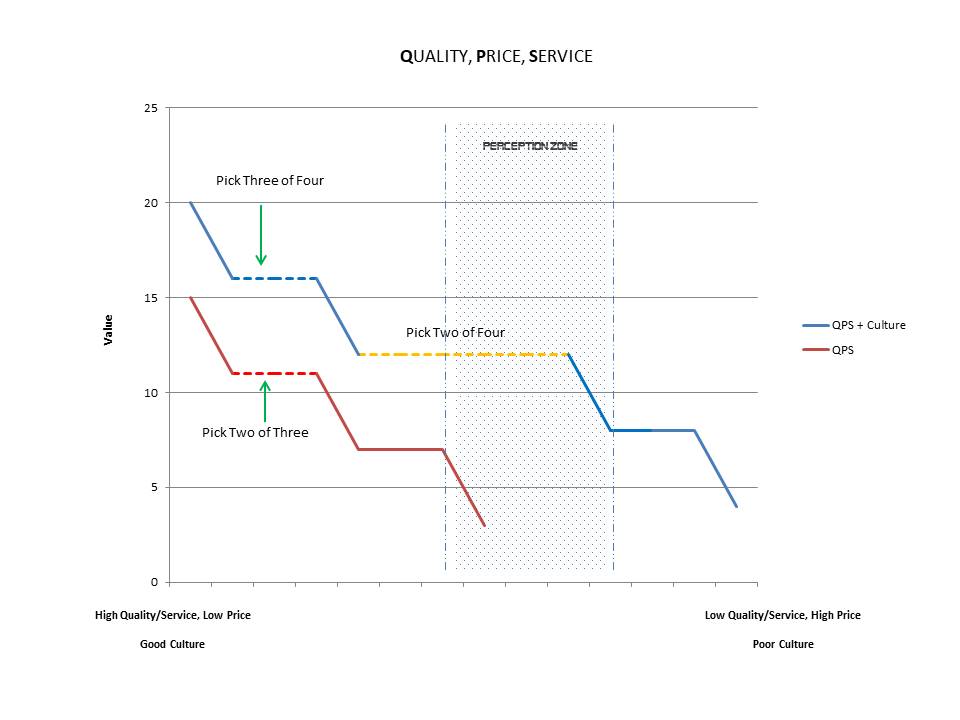Finding the Right Answer
There is another dimension often overlooked. Culture. Great company culture, not as defined by you and your employees but as defined by your customers, business partners, and competitors.
As business leaders, we contemplate where we should focus our organization’s efforts. What is the best use of our resources (people energy, time, and money)? All are limited and once utilized, are gone forever. How do we determine the best return on those investments?
When researching an external investment, say software for instance, you would want to identify the optimal mix of quality, price and service (QPS). There is an old adage…’Pick Two’. If you want good product and good service, you will pay a premium. If you desire good service and low price, you sacrifice quality, and so on. Anyone that says they offer all three are either losing their ass or lying (per the old adage).
There is another dimension often overlooked. Culture. Great company culture, not as defined by you and your employees but as defined by your customers, business partners, and competitors.
A definition of culture will help determine if that is where we need to invest. When looking externally, a great culture is defined by how well others treat you, how well others treat others, or how well others treat themselves.
Using that definition, I performed a very rudimentary analysis that added culture to the QPS equation with the hypothesis that ‘culture doesn’t matter’. The graph below illustrates the output of those matrices. When assigning the same value to each category (5 = Good and 1 = Poor) it illustrates that simply adding in culture does not necessarily move the needle, however adding in good culture pumps up the value.
Also discovered is the shaded area, the Perception Zone, where many people end up. They evaluate something only on the merits of QPS and do not take into consideration, culture. Culture exists, but if you do not account for it, you may end up with a distorted view of your investment and returns.
What happens is that with the QPS model, you pick two of three and if you consciously use the QPS + Culture model, you pick three of four. You end up in the perception zone if you disregard culture because it exists whether you recognize it as critical or not, whereby artificially inflating the value (your perception of the value).
When you do your external search for the solution that can help you gain a competitive advantage, or to improve productivity through automation, find an organization with people who actually care about you as much or more than they do about themselves. People can talk about partnerships and relationships all day long, but what really matters is how they behave.

Now, take the external evaluation and apply it internally. We offer good products and good service at a reasonable price, but what is our culture like? Do we invest in more product features, more service people, more operational efficiency, or in our culture?
Product features have economies of scale along with the risk of flat or diminishing returns over time. More people that operate more efficiently can provide a better service, but at what cost?
It is about people and it always will be. As a company, an organization of people, you can only control how you treat yourself and how you treat others.
My hypothesis was incorrect, culture does matter.I am not messing with our culture.
#SoftwareOnYOURTerms
Related Posts
Goldilocks Memory
Written by Henry Nelson, "Cloud success comes through simpler installation and friendlier user interfaces. Customization and ensuring data privacy on multi-tenant databases are continuing challenges for the cloud."
A Couple Hundred Billion
HarrisData has been an IBM business partner for decades.
Choose to be Delighted
Written by Tim Dunn Have you ever experienced Cognitive Dissonance while signing a contract? Your gut gets all tied up in knots and you wish you were somewhere else in that very moment.
45 Years of Software
Written By Henry Nelson. The customer focus matches HarrisData's culture and promise throughout our 45 years as an independent software vendor. Until a customer realizes benefits from our software, we have done nothing.
Cloud Inside
Written by: Lane Nelson What does it mean to put the cloud inside the application? It means that enterprise applications need to be built to leverage what works on the cloud from the inside out. Vendors that are trying to keep up with the web are scrambling to add SOAP and REST APIs to their existing products.

